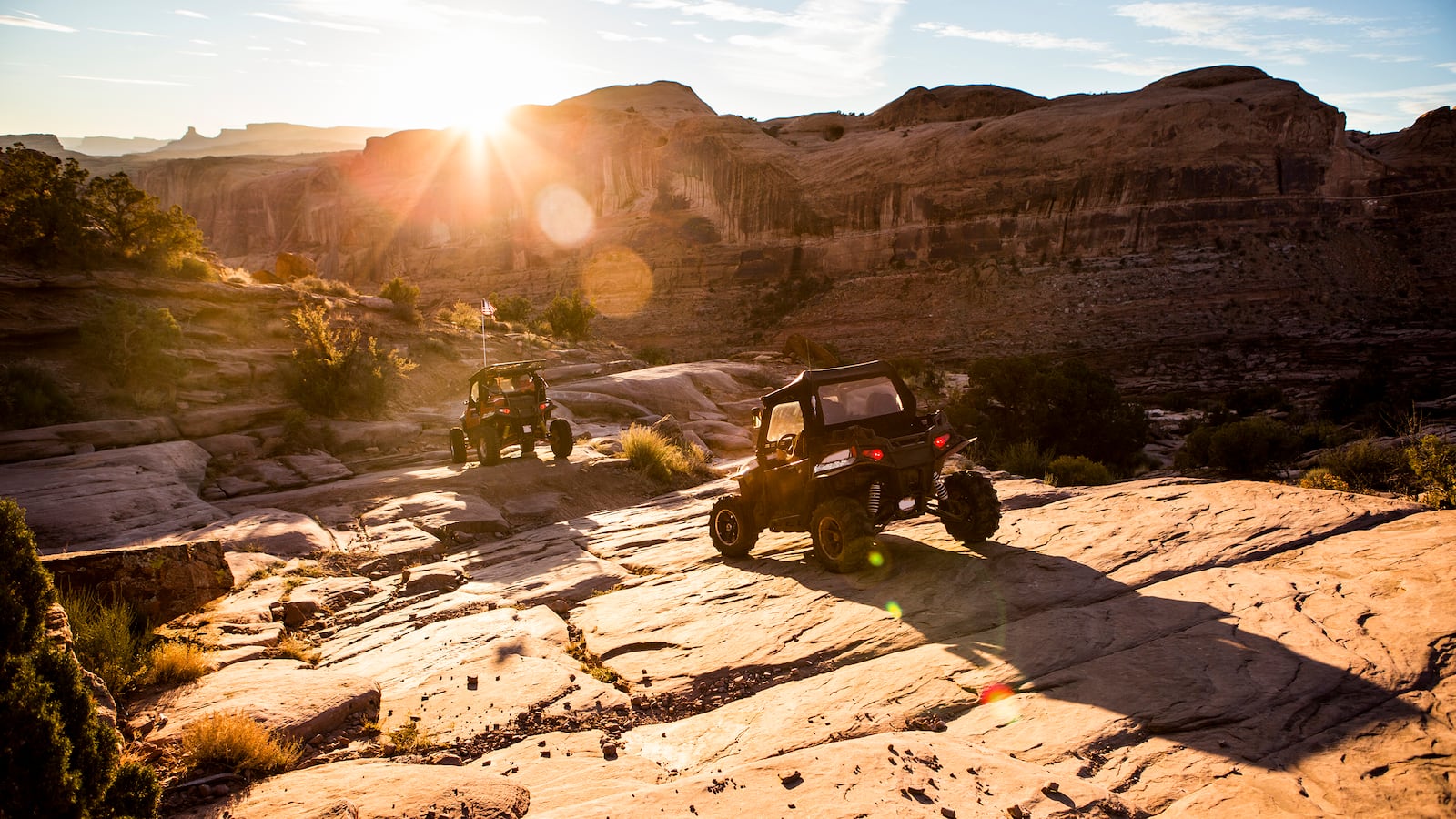Fans and enthusiasts of all-terrain vehicles (ATVs) are at war with environmentalists in Utah. And the National Park Service is in the middle of all of it.
This battle has been going on across the state for more than a decade, and it’s flared up in plenty of places in Utah, especially the hotspot ATV hub of Moab. But in 2018 the battle took a new turn when the National Park Service (NPS) decided to open up several existing trails in Glen Canyon National Recreation Area for the use of off-highway vehicles (OHV), a category of off-road-capable vehicles that includes 4x4s, Jeeps, Side by Sides, and ATVs.
Then, in September 2019, the federal government went a step further and moved to open up all of Utah’s national parks to OHVs in order to align with Utah state law, which allows street-legal OHVs on roads throughout the state. However, a month later, the feds reversed course, deciding to keep national parks in the state OHV-free.
There was one big exception to the ban: Glen Canyon remains one of 12 national park units, of which there are 398, open to OHVs. Perhaps this was because it is a national recreation area, or perhaps it was because the NPS had opened up the area before this move by the federal government.
In response to that exception, on Jan. 19, 2021, the National Park Conservation Association (NPCA), a nonprofit organization whose mission it is to protect and enhance America’s national park system, filed a lawsuit against the park service for “violating, among other provisions of the law, the Congressional mandates for [the land’s] management.”
Erika Pollard, the associate director of the Southwest region for the NPCA, told The Daily Beast that their concerns are multi-faceted. The NPCA is worried about the environmental impact these machines can have on the area’s ecology and the ecosystems within it, as well as the sound they produce that could detrimentally affect wildlife and disturb human visitors. But environmentalists are even more concerned about the capabilities these vehicles possess, such as their ability to tear up landscape and go off-road, potentially so far off-road as to end up in the neighboring Canyonlands National Park, where they are banned.
Of course, ATVers do not see it the same way.
Steven Hawkins, the president of the Utah ATV Association and a chairman of the Utah OHV Association, which represents approximately 10,000 OHV enthusiasts, called the lawsuit a publicity stunt and a fundraising opportunity. “They [the NPCA] are using this as propaganda to convince people that we should enact more wilderness destinations,” Hawkins told The Daily Beast.
Hawkins added that he believes the NPCA and similar environmental groups “make money off of these lawsuits,” explaining that when they file a suit, “they are taking in donations to fight in court.”
While the NPCA would like to protect more land—the organization’s main focus is on “protecting and enhancing America’s national park system for present and future generations”—the NPCA denied that they are fundraising via this legal battle, calling the very suggestion “obscene.”
Instead, the NPCA’s Pollard told The Daily Beast that they believe “the National Recreation Area should have some, mainly water-based, recreation opportunities for visitors.” She explained that this is how the Department of the Interior defines a National Recreation Area—as “lands near large reservoirs that offer visitors a chance to experience water-based outdoor activities—from swimming and kayaking to fishing and boating. These recreation areas also often include important natural and cultural features.”
However, Pollard argued, “this recreation should not come at the expense of conservation—which is our issue in Glen Canyon.”
ATVers fired back. Bud Bruening, president of the Utah OHV Association, told The Daily Beast, that “water has nothing to do with it” and trying to limit OHV use is “discriminatory.”
ATV groups have long complained of discrimination.
In a 2019 Outside article, Wes Siler, a contributing editor and ATV enthusiast, argued that there is a level of “gatekeeping” going on in our nation’s protected lands. In a critique of the perceived elitism he views going on among the outdoors community, Siler wrote that he believes elites “want to keep national parks full of [their] kind of people,” and “not the kind of people who ride ATVs.”
Bruening put it more bluntly: “If you can drive a car [on those trails] why not an OHV?” he asked. “When someone carries the same registration, same insurance, and same license, but they can’t drive the road or trail based on the looks of their machine, it’s discrimination.”
This argument stems from the larger fight off-road enthusiasts are engaged in within the state of Utah over whether they should be allowed to drive their vehicles on the state’s roads at all. Under state law, it is legal to drive ATVs on all city and county roads outside of Salt Lake County. This means that townships like Moab, which would like to ban ATV use on their roads due to noise complaints, cannot do so, and must lobby within the state legislature to make such amendments.
Yet national parks, managed by the federal government, do have that authority—and Dr. Kelly Bricker, chair of the Department of Parks, Recreation, and Tourism at the University of Utah, believes they should be wielding it. Bricker argues that discrimination is not occurring within the Park System. Instead, she likened ATVs to “the top predator in an ecosystem,” arguing that “Once you introduce motorized vehicles into a landscape, all of the other uses become secondary.”
Bricker believes that we already have too many roads in national parks and recreation areas. One of the issues she cited was the sound of these machines.
“Why do you go on a hike?” Bricker asked. For someone who lives in a busy city, the answer is easy—to escape, to enjoy some peace, quiet, and solitude.
“It’s like opening the floodgates—why not just make it Disneyland?” Bricker asked. “We have so few quiet spaces left and there’s so much being written about soundscapes. We know that non-natural sounds actually impact us in our stress and our blood pressure.” She went on to argue that ATVs are “obnoxiously loud,” and the “lengths you’d have to go to escape them while on a hike are tremendous, especially since when you allow them on these trails you extend the reach of their noise.” As for the park’s decision to allow them, Bricker believes this is “the Park deciding to prioritize the usage of ATVs over, say, a hiker.”
Soundscape ecology or bioacoustics, a growing field founded by Bernie Krause, a musician turned Ph.D., postulates that our world’s natural sounds are decreasing due to climate change and human impact, and the results on biodiversity could be huge.
ATVers are accustomed to noise complaints and adamantly reject the soundscape argument. Hawkins points out that “the federal government has put noise decibel limits on all ATVs and UTVs, which all manufacturers comply with.” While true, this argument ignores the fact that these decibel limits were designed for the health and safety of the riders, not for the protection of outdoor ecosystems and soundscapes.
Then there is the ecological damage.
“[The NPCA’s] complaints about ecological damage are completely false,” Hawkins argued. “We have seen many instances where after a rainstorm or snow, there is absolutely no evidence of damage done by use. In fact it usually will wipe out any trace of use.”
Of course, even the NPS, which is allowing ATVs, showed environmental impact from ATVs on continued use of these trails in their environmental impact study.
However, Mary Plumb, a spokesperson for the NPS and public information officer for Glen Canyon National Recreation Area, told The Daily Beast that the recreational uses outweigh the known environmental impacts in this case, writing in a statement that the park service believes their plan has helped expand and increase “recreational access to remote areas of the Glen Canyon National Recreation Area.” Plumb also noted that the environmental impact statement addresses the known environmental impact of ATV use, and the need for balancing “increased public demand for land-based recreational opportunities at the park.” All in all, the NPS believes “the end product properly balances visitor enjoyment with visitor safety and resource protection.”
This contradicts a 2008 NPS statement clarifying why ATVs should not be allowed in national parks. The statement reads, “The addition of off-road vehicle traffic on park roads will inevitably result in injury and damage to park resources. These specialized vehicles are designed, produced and marketed for the purpose of off-road travel, and they are uniquely capable of easily leaving the road and traveling cross country.” It also adds that no “reasonable level of law enforcement presence would be sufficient to prevent ATV and OHV use off roads. Park rangers will have no ability to pursue and apprehend vehicle users off road without adding to the damage they cause to park resources.”
Bricker argued that the move to allow ATVs in the recreation area is a misallocation of the NPS’ values, arguing they are overlooking the duality of their mandate, prioritizing one user group above the others, and opting to disregard their mission to protect and preserve in favor of allowing ATVs to run amok over the landscape. Bricker wondered whether the NPS should reconsider its approach, especially in light of climate change, which since 2008 has only become more severe.
While Bricker acknowledged parts of the NPS’ recent decision-making may be due to the Trump administration’s widely condemned relaxation of regulations concerning the park service, she hopes the Biden administration will soon chart a new, more protective course for the agency.
“The Park Service understands, through science, the impact we are facing,” Bricker said. “In the age where lands are being impacted by climate change and pollution, to encourage another use in our protected spaces that will increase greenhouse gas emissions is just beyond me.”






